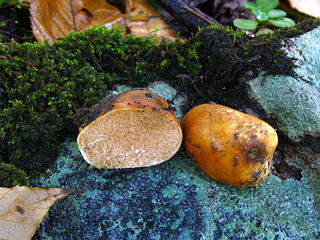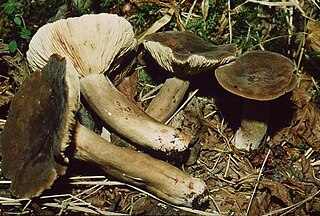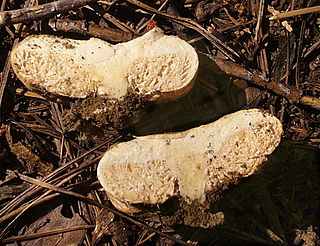| Lactarius lamprocystidiatus | |
|---|---|
| Scientific classification | |
| Kingdom: | |
| Division: | |
| Class: | |
| Order: | |
| Family: | |
| Genus: | |
| Species: | L. lamprocystidiatus |
| Binomial name | |
| Lactarius lamprocystidiatus Verbeken & E.Horak (2000) | |
Lactarius lamprocystidiatus is a member of the large milk-cap genus Lactarius in the order Russulales. Found in Papua New Guinea, it was first described scientifically by Verbeken and Horak in 2000. [1]

The Russulaceae are a diverse family of fungi in the order Russulales, with roughly 1,900 known species and a worldwide distribution. They comprise the brittlegills and the milk-caps, well-known mushroom-forming fungi that include some edible species. These gilled mushrooms are characterised by the brittle flesh of their fruitbodies.

Lactarius is a genus of mushroom-producing, ectomycorrhizal fungi, containing several edible species. The species of the genus, commonly known as milk-caps, are characterized by the milky fluid ("latex") they exude when cut or damaged. Like the closely related genus Russula, their flesh has a distinctive brittle consistency. It is a large genus with over 500 known species, mainly distributed in the Northern hemisphere. Recently, the genus Lactifluus has been separated from Lactarius based on molecular phylogenetic evidence.

Milk-cap is a common name that refers to mushroom-forming fungi of the genera Lactarius, Lactifluus, and Multifurca, all in the family Russulaceae. The common and eponymous feature of their fruitbodies is the latex ("milk") they exude when cut or bruised. Mushrooms with typical milk-cap characteristics are said to have a lactarioid habit. Some of them are edible.

Lactifluus volemus, formerly known as Lactarius volemus, and commonly known as the weeping milk cap or bradley, is a species of fungus in the family Russulaceae. It is widely distributed in the northern hemisphere, in temperate regions of Europe, North America and Asia as well as some subtropical and tropical regions of Central America and Asia. A mycorrhizal fungus, its fruit bodies grow on the ground at the base of various species of trees from summer to autumn, either individually or in groups. It is valued as an edible mushroom, and is sold in markets in Asia. Several other Lactifluus mushrooms resemble L. volemus, such as the closely related edible species L. corrugis, but these can be distinguished by differences in distribution, visible morphology, and microscopic characteristics. L. volemus produces a white spore print and has roughly spherical spores about 7–8 micrometres in diameter.
Lactarius cyanescens is a member of the large milk-cap genus Lactarius in the order Russulales. It was first described as new to science in 2007.
Lactarius mirabilis is a member of the large milk-cap genus Lactarius in the order Russulales. It was first described in 2007.

Lactarius sanguifluus, commonly known as the bloody milk cap, is a species of fungus in the family Russulaceae. First described from France in 1811, the species was given its current name by Elias Fries in 1838 when he transferred it to Lactarius. Found in Asia, Mediterranean Africa, and Europe, fruit bodies (mushrooms) grow scattered or in groups on the ground under conifers, especially Douglas fir. When bruised or cut, the fruit bodies ooze a blood-red to purple latex that slowly turns greenish upon exposure to air. The caps are orangish to reddish-brown, and become funnel-shaped with age. The gills are pinkish to purplish. Different forms have been described from Italy, but these are not universally accepted as distinct. L. sanguifluus mushrooms are edible, and sold in rural markets of Europe and Asia. Fruit bodies grown in polluted soil, including roadsides subject to heavy traffic, can bioaccumulate toxic heavy metals. Several sterols and pigment have been isolated and identified from the mushrooms.

Zelleromyces is a genus of fungi in the family Russulaceae. It was first described by mycologists Rolf Singer and Alexander H. Smith in 1960 to contain hypogeous (underground) fungi with gasteroid fruit bodies that "bleed" latex when they are cut.

Lactarius fuliginosus, commonly known as the sooty milkcap, is a species of fungus in the family Russulaceae. The medium-sized fruit bodies have velvety, grayish-brown caps and crowded gills. It is found in deciduous forests of Asia, Europe, and North America.
Lactarius acicularis is a member of the large milk-cap genus Lactarius in the order Russulales. Described as new to science in 2010, the species is found in Chiang Mai Province of northern Thailand, where it grows in rainforests that are dominated by Castanopsis armata, Dipterocarpus sp. and Lithocarpus. The specific epithet, acicularis, is derived from Latin and means "needle-shaped".
Lactarius vitellinus is a member of the large milk-cap genus Lactarius in the order Russulales. Found in northern Thailand, it was described as new to science in 2010.

Lactarius fennoscandicus is a member of the large milk-cap genus Lactarius in the order Russulales. It is found in Scandinavia, where it grows in a mycorrhizal association with spruce trees.

Lactifluus is one of three genera of mushroom-forming fungi containing species commonly named "milk-caps", the others being Lactarius and Multifurca. It has been separated from Lactarius based on molecular phylogenetic evidence but is very similar to that genus. There are roughly 150 known Lactifluus species, which have a mainly tropical distribution but are also found in the north temperate zone and Australasia. Some of them are edible mushrooms.
Lactifluus aureifolius is a species of agaric fungus in the family Russulaceae. It is found in Burundi, which grows in miombo woodland dominated by Brachystegia utilis. The fungus was described in 1996 as a species of Lactarius.

Arcangeliella is a genus of gasteroid fungi in the family Russulaceae. Taxonomic and phylogenetic research has shown that it is very likely a synonym of Lactarius. The type species Arcangeliella borziana was moved to Lactarius in 2003. However, the genus name is still in use for several species for which new combinations have not yet been proposed.
Gastrolactarius is a genus of gasteroid fungi in the family Russulaceae. Although currently valid, this taxon is very likely a synonym of Lactarius.

Lactifluus clarkeae, formerly known as Lactarius clarkeae, is a species of mushroom-forming fungus in the family Russulaceae. It is found in Australia and New Zealand in mycorrhizal association with species of Nothofagus and the family Myrtaceae.
Egon Horak is an Austrian mycologist who has described more than 1000 species of fungi, including many from the Southern Hemisphere, particularly New Zealand and South America. He was an executive editor of the scientific journal Sydowia from 1975 to 1989, and a member of the editorial board afterwards.